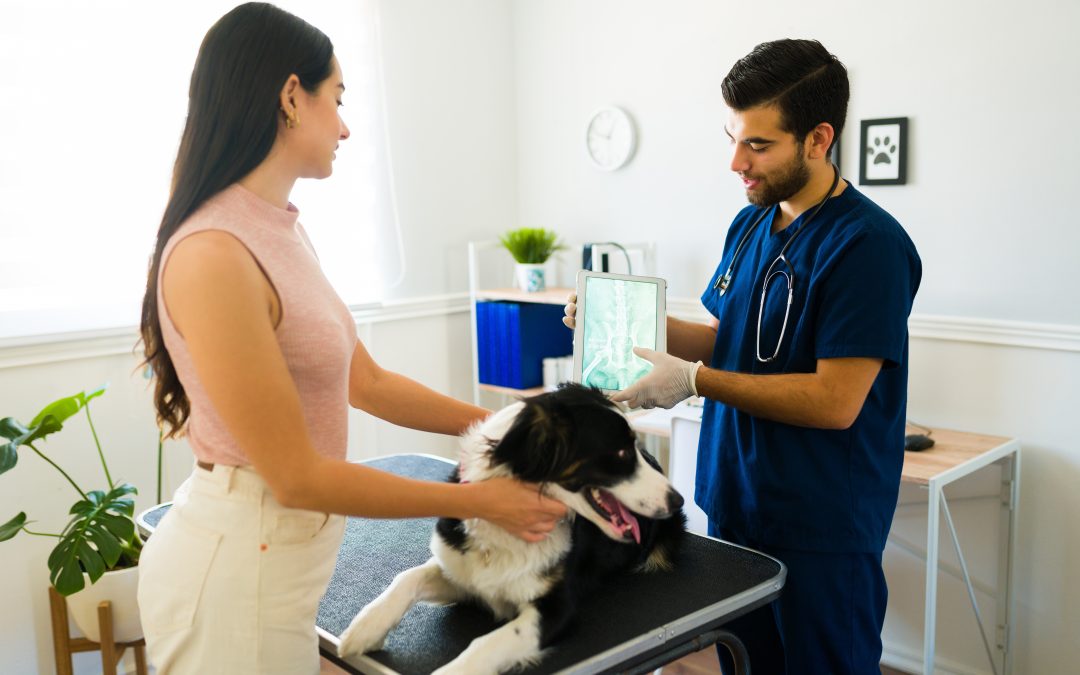The article explores the challenges of variability in veterinary radiology interpretations and how integrating AI in veterinary diagnostics can improve consistency, accuracy, and efficiency in diagnostic imaging. It highlights the role of AI as a supportive image screening tool that complements expert veterinary radiologists. In this article we’ll cover how:
- Radiograph interpretation can vary based on bias, experience, image quality, and clinical context.
- The use of AI in veterinary radiology can reduce interpretation inconsistencies.
- AI reports support—rather than replace—veterinary experts, helping boost accuracy and consistency in diagnostic imaging
Understanding Variability in Veterinary Radiology Interpretations
Veterinary radiology is a common diagnostic tool used to evaluate conditions ranging from orthopedic injuries to internal diseases. However, the reality is that radiologists don’t always agree on an image’s interpretation. Unlike laboratory tests with definitive results, radiology reports are clinical opinions, influenced by individual expertise, experience, and subtle differences in image quality. This variability in diagnosis can lead to differences in treatment recommendations and patient outcomes.
In this article, we look at the factors that influence these discrepancies and how advancements in artificial intelligence (AI)-assisted veterinary radiology can help improve consistency in diagnostic imaging reporting.
Reasons for Variability in Veterinary Radiology
Radiology combines art and science, and differences in image interpretation are common, even among board-certified radiologists. Radiology reports rely on expert opinion, which can vary based on several factors:
- Subjectivity and cognitive bias — Radiologists rely on pattern recognition to identify abnormalities, and subtle differences in perception and cognitive bias can lead to different conclusions. For example, confirmation bias may make the radiologist see what aligns with their expectations, and anchoring bias can make them stick to an initial assessment.
- Experience — A radiologist’s experience can influence their interpretative skills and diagnostic approach, and their background can shape how they assess an image. For instance, specialists in orthopedic imaging may emphasize bone structure, while those with soft tissue expertise may focus more on organ abnormalities.
- Image quality — Underexposed or overexposed images can obscure fine details, and poor patient positioning may affect visibility, leading to misinterpretation.
- Clinical context — Veterinary radiologists are trained to interpret images without first looking at the patient’s history to keep their assessment objective. That said, a strong clinical history that includes exam findings and relevant background helps shape a more complete and accurate report. The more context a radiologist has, the better they can tailor conclusions and recommendations. In some cases, the same images might lead to different interpretations depending on the clinical details provided.
- Complex cases — Some conditions, such as early-stage tumors, inconspicuous fractures, or certain lung diseases, can present with subtle or overlapping features, making classification difficult. Differences in how radiologists weigh the significance of these findings can lead to varying interpretations.
- The human factor — Radiologists are humans, and issues such as fatigue and time constraints can impact diagnostic accuracy. Evaluating hundreds of images per day can also impact a radiologist’s mental focus, and a heavy workload may lead to less thorough evaluations.
Radiologist Consensus and Variability
When developing our veterinary AI radiology tool, the Vetology team set out to understand where radiologists consistently agreed—and where their interpretations differed. Identifying conditions with high agreement rates between different radiologists guides our selection criteria for building new AI classifiers. Studying patterns of diagnostic variability helps train the models to better handle ambiguous cases.
This process isn’t static. Our models continue to evolve through regular retraining, and input from real-world clinical use. Feedback from veterinarians and our internal human case reviews play a key role in flagging areas where the AI might need more structure or refinement. It’s all part of our goal to ensure the AI aligns with expert-level thinking and delivers meaningful support.
To support our understanding of diagnostic consistency, the team asked veterinary radiologists—without any involvement from AI—to independently evaluate and diagnose images with a wide variety of canine conditions. The radiologists showed high levels of agreement with one another on conditions such as pregnancy, urinary stones, hepatomegaly, small intestinal obstruction, cardiomegaly, pericardial effusion, and esophageal enlargement. In other words, these diagnoses were more consistently interpreted across different experts.
In contrast, there was noticeably lower agreement among radiologists on conditions like pyloric gastric obstruction, right kidney size, subtle or suspicious nodules, and bronchiectasis, indicating that these findings tend to generate more varied interpretations even among experienced professionals.
How AI Compares
AI has demonstrated significant potential in enhancing diagnostic processes and reducing variability when reading radiographs. For example, the Vetology team found that the radiologist agreement rate for canine hepatomegaly was 92%, while the Vetology AI tool had an 87.29% sensitivity and a 92.34% specificity. Third-party peer reviews also demonstrate the product’s value.
Researchers at Tufts University, Cummings School of Veterinary Medicine, performed a retrospective, diagnostic case-controlled study to evaluate the performance of Vetology AI’s algorithm in the detection of pleural effusion in canine thoracic radiographs. Sixty-one dogs were included in the study, and 41 of those dogs had confirmed pleural effusion. The AI algorithm determined the presence of pleural effusion with 88.7% accuracy, 90.2% sensitivity, and 81.8% specificity.
Researchers at the Animal Medical Center in New York, New York, performed a prospective, diagnostic accuracy study to evaluate the performance of Vetology AI’s algorithm in diagnosing canine cardiogenic pulmonary edema from thoracic radiographs, using an American College of Veterinary Radiology-certified veterinary radiologist’s interpretation as the reference standard. Four hundred eighty-one cases were analyzed. The radiologist diagnosed 46 of the 481 dogs with cardiogenic pulmonary edema (CPE). The AI algorithm diagnosed 42 of the 46 cases as CPE positive and four of the 46 as CPE negative. When compared to the radiologist’s diagnosis, the AI algorithm had a 92.3% accuracy, 91.3% sensitivity, and 92.4% specificity.

